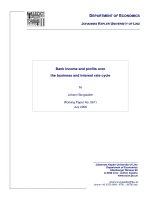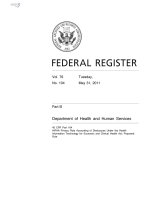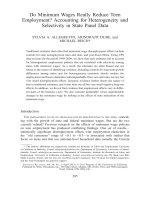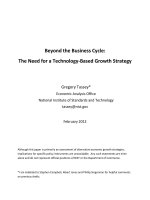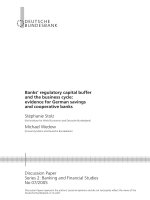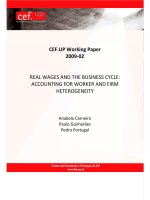REAL WAGES AND THE BUSINESS CYCLE: ACCOUNTING FOR WORKER AND FIRM HETEROGENEITY potx
Bạn đang xem bản rút gọn của tài liệu. Xem và tải ngay bản đầy đủ của tài liệu tại đây (450.64 KB, 38 trang )
CEF.UP Working Paper
2009-02
REAL WAGES AND THE BUSINESS CYCLE:
ACCOUNTING FOR WORKER AND FIRM
HETEROGENEITY
Anabela Carneiro
Paulo Guimarães
Pedro Portugal
Real Wages and the Business Cycle: Accounting for Worker
and Firm Heterogeneity
1
Anabela Carneiro
Universidade do Porto and CEF.UP
2
Paulo Guimarães
University of South Carolina, CEF.UP
2
and IZA Bonn
Pedro Portugal
3
Banco de Portugal, Universidade NOVA de Lisboa and IZA Bonn
November 2009
1
We thank John T. Addison, António Antunes, Manuel Arellano, Olivier Blanchard, V. V.
Chari, Thomas Lemieux, Mark Gertler, Christian Heafke, Chris Pissarides, Julian Rotemberg,
Frank Smets, Carlos Robalo Marques, Antonella Trigari, and participants at the Banque de France
conference in Paris, the WDN in Frankfurt, and the AEA conference in San Francisco for helpful
comments and suggestions. We also thank Lucena Vieira for outstanding computational assistance.
We are grateful to Fundação para a Ciência e Tecnologia for financial support.
2
CEF.UP - Centre for Economics and Finance at University of Porto - is supported by the
Fundação para a Ciência e a Tecnologia (FCT), Portugal.
3
Corresponding author: Avenida Almirante Reis, 71, 1150-165 Lisboa, Portugal; tel.: 351 21
3128410; e-mail:
Abstract
Using a longitudinal matched employer-employee data set for Portugal over the 1986-
2005 period, this study analyzes the heterogeneity in wages responses to aggregate labor
market conditions for newly hired workers and existing workers. Accounting for both
worker and firm heterogeneity, the data support the hypothesis that entry wages are much
more procyclical than current wages. A one-point increase in the unemployment rate
decreases wages of newly hired male workers by around 2.8% and by just 1.4% for workers in
continuing jobs. Since we estimate the fixed effects, we were able to show that unobserved
heterogeneity plays a non-trivial role in the cyclicality of wages. In particular, worker
fixed effects of new hires and separating workers behave countercyclically, whereas firm
fixed effects exhibit a procyclical pattern. Finally, the results reveal, for all workers, a
wage-productivity elasticity of 1.2, slightly above the one-for-one response predicted by
the Mortensen-Pissarides model.
JEL classification: J31; E24; E32;
Keywords: wage cyclicality; hires; firm-specific effects; compositional effects; labor
productivity
1 Introduction
The cyclical behavior of real wages has been the subject of many studies since the debate
of Keynes (1939), Dunlop (1938), and Tarshis (1939). Earlier studies based on aggregate
data showed some ambiguous results. In this case, the best conclusion is that the choice
of the time period analysis, price deflator, and cyclical indicator, as well as the choice
between wage rates and average earnings (including overtime or not), may substantially
affect the estimates of real wage cyclicality [Abraham and Haltiwanger (1995)]. One reason
why these studies have reached no definitive conclusions resides in the fact that they have
been performed at the aggregate level. In particular, they have ignored the changes in
the composition of the workforce over the cycle. The presence of compositional effects
has attracted much attention in the last years and recent micro-data studies based on
panel data for the U.S. showed that composition bias plays an important role on real wage
behavior along the business cycle [see, for example, Mitchell et al. (1985), Bils (1985),
Keane et al. (1988) and Solon et al. (1994)]. In fact, cyclical changes in the composition
of the work force may induce a countercyclical bias in the aggregate real wage. Aggregate
measures of real wages tend to give more weight to low-skill workers during expansions than
during recessions. The argument is that if less-skilled workers are more vulnerable to layoff,
they will account for a smaller share of employment in recessions than in expansions. An
additional general problem of aggregation is that it assumes that the relationship between
real wages and the business cycle is the same for all individuals or groups of individuals.
If wrong, the estimates of real wage cyclicality include a specification bias.
Over the last two decades, a number of studies based on micro-panel data for the
U.S. (and recently for Britain) point quite decisively toward a procyclical behavior of real
wages.
1
Panel microdata also show that real wage changes of job movers are much more
procyclical than real wage changes of job stayers [see Solon et al. (1994), Shin (1994) and
Devereux (2001) for the U.S. and Devereux and Hart (2006) and Hart (2006) for Britain].
1
For insightful surveys see Brandolini (1995) and Abraham and Haltiwanger (1995).
1
Several theoretical explanations have been advanced in order to explain why job chang-
ers have more procyclical wages. The most frequent explanation relies on the existence of
interindustry wage differentials. This interpretation was first advanced by Okun (1973),
who argued that certain jobs offer rents to workers. If these sectors are also more cyclically
sensitive, workers can switch into high-paying jobs during booms because such jobs are less
tightly rationed during these times.
Beaudry and DiNardo (1991) advanced a more convincing explanation for the differ-
ences in wage cyclicality between job stayers and job changers, even though their ex-
planation abstracts from heterogeneity across jobs. According to their findings, current
unemployment rate does not affect wages after controlling for the best labor market condi-
tions since a worker was hired at his/her current job. Indeed, when workers are not mobile
between employers, current labor market conditions do not affect current wages. In this
case, current wages are negatively correlated with the unemployment rate at the time each
worker was hired. However, if workers are very mobile, wages are correlated with the best
labor market conditions observed since the worker was hired.
Barlevy (2001) offered a new explanation for the existence of more procyclical wages of
job changers: compensating differentials. In order to show that compensating differentials
instead of interindustry wage differentials generate a more procyclical behavior of wages
of changers, Barlevy developed a model that relates unemployment insurance and wage
cyclicality. His empirical finding of a negative relationship between wage cyclicality among
job changers and the level of unemployment insurance benefits, supports the view that
job changers’ wages are more procyclical because in booms they obtain jobs that pay a
compensating differential for the risk of layoff. In this case, workers who change jobs during
booms may not realize true gains from the higher wages they receive, since these gains are
typically offset during recessions.
Recent microeconometric evidence on wage cyclicality also gave a new insight to the
discussion about business cycle fluctuations of unemployment and vacancies and wage
2
stickiness. Indeed, some authors argue that the Mortensen-Pissarides [Mortensen and Pis-
sarides (1994) and Pissarides (2000)] search and matching model cannot explain the cyclical
volatility of unemployment and vacancies [Hall (2003) and Shimer (2005)]. Furthermore,
they also show that if the hypothesis of rigid wages is introduced, the model performs much
better in matching fluctuations in unemployment and vacancies.
In a recent exercise, however, Pissarides (2007) showed that the wage stickiness hypoth-
esis does not seem to match the empirical data. Exploring the idea that in the search and
matching model job creation is driven by the difference between the expected productivity
and the expected cost of labor in new matches, Pissarides shows that in equilibrium the
wages negotiated in new matches are about as cyclical as productivity. This prediction of
the model seems to be consistent with the empirical evidence that wages in new matches
are much more procyclical than wages in continuing jobs.
Haefke et al. (2007) also defend this point of view. Using the Current Population
Survey (CPS) they showed that wages of newly hired workers are much more volatile than
aggregate wages and respond one-to-one to changes in labor productivity.
In this context, the motivation to empirical research is to have appropriate data that
allow testing if wages in new matches are more volatile than those in continuing jobs. As
mentioned above, previous empirical studies have been showing that job changers’ wages
are much more procyclical than job stayers’ wages. However, and since these studies do not
seem to fully control for compositional effects, it can always be argued that the empirical
evidence merely reflects the impact on wages of workers drifting from low wage firms to
high wage firms in expansions, and vice-versa during recessions.
This paper adds to the empirical literature on wage cyclicality in several ways. The
main contribution is the analysis of the impact of the cycle on real wage growth of new
hires versus stayers within the same firm. The key question to be answered is: are starting-
wages, conditional on the long-term wage policy of the firm, more sensitive to the economic
cycle? To the best of our knowledge, this is the first study that explicitly deals with
3
this issue controlling simultaneously for worker and firm unobserved heterogeneity, which
allows handling of both sources of composition bias in wage cyclicality. In fact, beyond
the possibility that average worker quality may change over the cycle, for several reasons
job quality may also exhibit a cyclical pattern. Some authors have provided evidence
that in recessions individuals take lower-paying jobs that dissolve more quickly whereas
in expansions firms create high-paying jobs that last longer (see, for example, Beaudry
and DiNardo (1991) and Bowlus (1995)). Furthermore, the industry composition may also
change over the cycle. This paper points out the importance of controlling for both worker
and firm unobserved heterogeneity when analyzing the cyclical behavior of wages. Worker
and firm unobserved heterogeneity, both respond strongly to changes in unemployment
rates.
For this purpose a unique and rich matched employer-employee longitudinal data set -
Quadros de Pessoal - will be used and a new iterative procedure that provides the exact
OLS solution to the two-way fixed effects model will be employed.
Two additional contributions of this paper deserve attention. The first is to test if the
impact of the unemployment rate on wages really reflects labor-market tightness disentan-
gling between the job finding probability and the job separation probability. Finally, we
analyze how the two components of observed wages - bargained wage and the wage cushion
- evolve over the cycle.
This paper is organized as follows. Section 2 presents the architecture of the Portuguese
wage setting system. In Section 3 the data set and methodology are described. The main
results and some robustness checks are discussed in Section 4. Conclusions are outlined in
Section 5.
4
2 The Architecture of the Portuguese Wage Setting System
2.1 Collective Bargaining
The Portuguese Constitution provides the juridical principles of collective bargaining and
grants unions the right to negotiate. The effects of the agreements are formally recognized
and considered valid sources of labor law.
Concerning the bargaining mechanisms, a distinction should be made between the con-
ventional regime and the mandatory regime. Conventional bargaining results from direct
negotiation between employers’ and workers’ representatives. A mandatory regime, on the
other hand, does not result from direct bargaining between workers and employers, being
instead dictated by the Ministry of Labor. The Ministry can extend an existing collective
agreement to other workers initially not covered by it or it can create a new one, if it
is not viable to extend the application of an existing document. A mandatory regime is
applied when workers are not covered by unions, when one of the parties involved refuses
to negotiate, or bargaining is obstructed in any other way.
2
Therefore, the impact of col-
lective bargaining goes far beyond union membership and the distinction between union
and non-union workers or firms becomes meaningless.
Usually collective negotiations are conducted at the industry or occupation level. Firm-
level negotiation, which for a time was a common practice in large public enterprises,
has lost importance. The law does not establish mechanisms of coordination between
agreements reached in different negotiations; however preference is given to vertical over
horizontal agreements, and the principle of the most favorable condition to the worker
generally applies.
Since most collective agreements are industry-wide, covering companies with very dif-
ferent sizes and economic conditions, their contents tend to be general, setting minimum
2
Beyond the existence of compulsive extension mechanisms, voluntary extensions are also possible, when
one economic partner (workers’ representative or employer) decides to subscribe to an agreement that it
had initially not signed.
5
working conditions, in particular the base monthly wage for each category of workers,
overtime pay and the normal duration of work. Moreover, only a narrow set of topics is
updated annually, and therefore the content of collective agreements is often pointed out
as being too immobile and containing little innovation.
Whatever the wage floor agreed upon for each category of workers at the collective
bargaining table, firms are free to pay higher wages, and they often deviate from that
benchmark, adjusting to firm-specific conditions [see Cardoso and Portugal (2005)].
The Portuguese system of industrial relations apparently presents features of a central-
ized wage bargaining system. Indeed, massive collective agreements, often covering a whole
industry, predominate in the economy, while firm-level collective bargaining covers a low
proportion (less than 10 percent) of the workforce. Moreover, trade union confederations,
employers’ federations and the Government meet at the national level each year to set a
guideline for wage increases (the so-called “social concertation”). However, this guideline
is not mandatory and merely guides the collective bargaining that follows. The Council
for Social Concertation, later replaced by the Social and Economic Council, was created in
1984 as a tripartite forum (government, workers, and employers’ representatives) with the
aim of promoting “social concertation”, but its role concerning income and wage policies
remains limited.
On the other side, the fragmented nature of the trade union structure, the fragmented
employers’ associations and the multiplicity of bargaining units provides the system with
a certain degree of decentralization. Even though collective bargaining in Portugal takes
place at a sectorial level and most workers are covered by the bargaining system due
to the existence of mandatory extensions, the coordination between bargaining units is
rather limited. In fact, the right to negotiate is given to every employer or employers’
association and to every trade union (regardless of the number of affiliated members they
represent), and the parties have the possibility of choosing the level of negotiation - regional,
occupational, industrial, or national. This leads to the existence of a diffuse and complex
6
system of wage bargaining with negotiation fragmented and agreements multiplied.
2.1.1 Minimum Wages
A mandatory minimum monthly wage was set for the first time in Portugal in 1974, covering
workers aged 20 or older and excluding agriculture and domestic servants. Currently, there
is a single legal minimum wage that applies to all workers. Workers formally classified as
apprentices receive just 80 percent of the full rate.
The minimum wage is updated annually by the parliament, under government pro-
posal.
3
Decisions on the level of the minimum wage are taken on a discretionary basis,
usually taking into account past and predicted inflation and after consulting the social
partners.
In 2005, the minimum monthly wage level was 374.7 €, representing 40 percent of the
average monthly wage in the private sector. In this same year the proportion of workers
that received the minimum legal wage was about 5 percent.
4
3 Data and Methodology
3.1 Data Description
Data for this study come from a unique and rich matched employer-employee data set -
Quadros de Pessoal (QP). QP is a mandatory annual employment survey collected by the
Portuguese Ministry of Labor and Social Solidarity, which covers virtually all establish-
ments with wage earners.
5
Indeed, each year every establishment with wage earners is
legally obliged to fill in a standardized questionnaire. Requested data cover the establish-
ment itself (location, industry, and employment), the firm (location, industry, employment,
sales, ownership, and legal setting) and each of its workers (gender, age, education, skill,
3
The only exceptions are 1982, when it was not updated, and 1989, when it was updated twice.
4
Source: Ministry of Labor and Social Solidarity (GEP) - Earnings Survey.
5
Public administration and non-market services are excluded.
7
occupation, admission date, earnings, and duration of work). The information on earnings
is very complete. It includes the base wage (gross pay for normal hours of work), regular
benefits, irregular benefits, and overtime pay, as well as the mechanism of wage bargaining.
Information on normal and overtime hours of work is also available.
Eighteen spells of QP, from 1986 to 2005, were available for this study.
6
From 1986 to
1993 the information was collected in March of each year, and since 1994, in October.
There are three main reasons that make this survey a good source for the study of
wage cyclicality. The first is its coverage. By law, the questionnaire is made available
to every worker in a public space of the establishment. This requirement facilitates the
work of the services of the Ministry of Labor that monitor compliance of firms with the
law (e. g., illegal work). Indeed, the administrative nature of the data and its public
availability implies a high degree of coverage and reliability. Currently, the data set collects
data on about 350,000 firms and 3 million employees. Second, this survey is conducted
on a yearly basis, and its identifying scheme allows accurate identification of firms and
workers, making it possible to track them over the years. Each firm entering the database
is assigned a unique identifying number and the Ministry implements several checks to
ensure that a firm that has already reported to the database is not assigned a different
identification number. Using this identifier it is possible to pinpoint all firms that have
entered and exited economic activity. The workers’ identification number is based on a
transformation of his/her social security number. We match the individuals over the years
based on their identification number, gender, year and month of birth. Finally, this source
enables the matching of firms and their workers, which allows us to classify the situation of
the worker on the job (stayer/mover, accession/separation). Moreover, employer-reported
wage information is known to be subject to less measurement error than worker-reported
data.
Our data set includes the population of full-time wage earners in the private non-farm
6
Worker level files are not available for the years of 1990 and 2001.
8
sector, aged between 20 and 55 years old.
7
We have also excluded those individuals for
whom an explanatory variable is not available for a particular year, namely those with no
information on wages and hours worked. In order to minimize the effects of outliers in
wages, we dropped 1 percent of the observations corresponding to the top and bottom tails
of the wage distribution.
In order to control for workers’ unobserved heterogeneity using a first-differences ap-
proach, most empirical studies on real wage cyclicality tend to restrict the sample to workers
employed for two consecutive years. In this study this restriction is avoided in order to
be able to include in the analysis those individuals with a weak labor force/employment
attachment. Thus, our data set includes the individuals that are present in two consecutive
years,
8
but also contains those individuals that are present in the QP registers in year t
but are absent in year t + 1 (hereinafter ‘separations’).
9
It also includes the newly hired
workers, the so-called ‘accessions’. A worker is classified in period t as newly hired if his
tenure in that year is less than or equal to 12 months. In this context, a newly hired worker
may refer to an individual that moved between firms or to an individual that comes from
non-employment or the public sector.
Employees present in two consecutive years may also be classified as ‘stayers’ or ‘movers’.
A ‘stayer’ is identified as a worker that was employed in the same firm for two consecutive
years. A ‘mover’ is defined as a worker that moved to a different firm from period t − 1 to
period t.
The male population includes 14,242,814 year×individuals observations, corresponding
to around 4 million individuals matched by identifying number and date of birth. Accord-
ing to Table 1, male stayers are numerically the most important group, corresponding to
7
In agriculture a considerable amount of payments are non-pecuniary. We thought it better to exclude
these workers from the analysis. In any case, the number of these workers is almost negligible.
8
It should be noted that when a worker is present in the QP registers in more than one firm in a given
year, we then retain the record for the firm in which the worker had the highest number of hours worked.
9
Hence, separations are only identified between 1986 and 2004.
9
10,882,692 observations. Furthermore, 1,203,119 observations refer to movers, 2,410,850
to new hires, and 3,445,218 to separations. The female population contains 9,398,893
year×individuals observations, corresponding to around 2.9 million individuals. Female
stayers correspond to 7,005,185 observations, movers to 672,821, accessions to 1,606,385
observations, and separations to 2,415,541. It should be noted that, in a given year, an
individual may be classified simultaneously as an accession and separation or, for example,
as a mover and a new hire. Thus, the sum of the observations in each of the four groups
does not correspond to the total number of observations.
Hereinafter, we will focus our attention on stayers, accessions and separations.
Table 1: Data Set Composition
Males Females
Stayers 10,882,682 7,005,185
Movers 1,203,119 672,821
Accessions 2,410,850 1,606,385
Separations 3,445,218 2,415,541
Tables A.1.1 and A.1.2 in Appendix A describe the data for male and female workers,
respectively.
3.2 Empirical Methodology
The empirical model that will be used to test for real wage cyclicality is a level wage
equation with controls for worker observed and unobserved heterogeneity, firm unobserved
heterogeneity, and business cycle conditions. The option to define the wage equation in
levels is justified by the need to estimate the model for workers’ hires and separations since,
by construction, panel data are not available in these two cases. Thus, in order to account
for worker/firm unobserved heterogeneity, the fixed-effects estimator will be used instead
of the standard first-differences estimator. This avoids restricting the sample to solely
10
continuously employed workers. The main problem with this procedure is that workers or
firms that appear only once over the entire period of analysis are excluded.
10
The static form of the model is:
log w
ift
= λ
i
+ γ
f
+ α
0
t + α
1
t
2
+ x
if t
β + ξ cycle
t
+ u
ift
where log w
ift
is the natural logarithm of the real wage of individual i, in firm f at time
t, cycle
t
is a cyclical indicator such as the aggregate unemployment rate,
11
t and t
2
are
a time trend and its square and x
ift
is a vector of time-varying worker characteristics.
λ
i
is an unobserved worker fixed effect, γ
f
a firm-specific effect, and u
if t
is a zero-mean
random term with constant variance. Since we are particularly interested in comparing
the behavior of real wages over the cycle between stayers, accessions, and separations, the
model also includes dummy variables for hirings and separations and an interaction term
between those dummies and the cyclical indicator.
The coefficient of interest is ξ. If the cyclical indicator corresponds to the unemploy-
ment rate, the parameter ξ measures the percent wage change in response to a one-point
increase in the unemployment rate. A negative value of ξ implies that wages rise when un-
employment falls, so that wages are procyclical. If, on the contrary, ξ is positive, wages are
countercyclical. As mentioned before, the job finding and the job separation probabilities
will also be used as measures of the business cycle.
12
10
Thus, all firm-worker singletons were excluded from the data set, representing around 21% of the total
number of observations.
11
Since wages are set at least six months to one year in advance, there is a delayed relationship between
wages and economic growth. To capture this lagged effect we use the unemployment rate of the previous
year.
12
We thank Olivier Blanchard for this suggestion.
In Table A.2 of Appendix A the unemployment rate, the job finding probability, and the job separation
probability are reported for the 1985-2005 period.
11
4 Empirical Results
4.1 Real Wage Sensitivity to the Unemployment Rate
Table 2 reports the estimates of the coefficient of the unemployment rate with respect to
wages (ξ) for male workers. Besides the aggregate unemployment rate, each regression
includes age (and its square) as a proxy for labor market experience, a set of dummies
for worker’s qualification and education levels and a quadratic time trend. The dependent
variable is defined as the natural log of real hourly earnings. Hourly earnings correspond to
the ratio of total regular payroll and total number of normal hours. Total regular payroll
includes base wages, seniority payments and regular benefits. The wages were deflated
using the Consumer Price Index (CPI) and are expressed in 1985 Euros.
13
The standard OLS estimates exhibit a strong procyclical behavior of real wages for all
workers. A 1-percentage point (p. p.) decrease in the national unemployment rate raises
hourly earnings of male stayers by 3.17 percent, by 3.59 percent for newly hired workers
and by 3.5 percent for recently separated workers.
Controlling for firm unobserved heterogeneity leads to a reduction in the semi-elasticities
estimates of wages with respect to the unemployment rate, most notably for separations.
The results also reveal that real wages of newly hired workers are more responsive to cycle
fluctuations than real wages of separating workers or workers in continuing jobs. A 1-p. p.
decrease in the national unemployment rate raises hourly earnings of newly hired workers
by 3.53 percent and by only 2.94 percent and 2.72 percent, respectively, for stayers and
separating workers.
Accounting only for worker unobserved heterogeneity yields to a further decrease in
the semi-elasticities of wages, deepening the difference across stayers/separations and ac-
cessions. The semi-elasticities of wages with respect to the unemployment rate are -1.5
percent, -2.73 percent, and -1.45 percent for stayers, accessions, and separations, respec-
13
Between 1986-93 the price index refers to March of year t − 1 to March of year t, whereas from 1994 to
2005 the price index corresponds to October of year t − 1 to October of year t.
12
tively. Comparing with previous empirical studies that use micro panel data, we can say
that the estimate for stayers lies slightly below the bound of -1.93 obtained by Devereux
and Hart (2006) for the U.K
14 15
Finally, the wage level equation was re-estimated including both a worker and a firm
fixed effect. Estimation of a model with two high-dimensional fixed effects is a non-trivial
problem. In Appendix B we discuss our estimation strategy, which provides the exact OLS
solution.
The unemployment rate coefficient estimates from the two fixed effects model are pre-
sented at the bottom of Table 2. These results corroborate our previous findings. First,
once worker and firm heterogeneity are accounted for, no significant differences are found in
the estimates of the cyclicality of hourly earnings between stayers and separations. Second,
entry wages are much more procyclical than current wages. In particular, we found that a
1-p. p. increase in the unemployment rate decreases hourly earnings by 1.41 percent for
male stayers and by 2.77 percent for newly hired workers.
14
For a recent summary of these results see Pissarides (2007).
15
Using the data set from Quadros de Pessoal for the 1986-2004 period, Martins (2007) obtained an
estimate for male workers employed in two consecutive years of -0.62. The difference behind these results
may reside in the estimation procedure employed by the author, who used a two-stage first differences
estimator.
13
Table 2: Real Wage Sensitivity to the Unemployment Rate - Men
Portugal, 1986-2005 (N=11,204,120)
Dependent variable: log of real hourly earnings
Stayers Accessions Separations
OLS estimator
Cycle variable: Unemployment Rate -3.17 -3.59
-
3.50
Standard errors (0.014) (0.039) (0.030)
Within estimator, firm fixed effects
Cycle variable: Unemployment Rate -2.94 -3.53 -2.72
Standard errors (0.001) (0.035) (0.020)
Within estimator, worker fixed effects
Cycle variable: Unemployment Rate -1.50 -2.73 -1.45
Standard errors (0.001) (0.021) (0.016)
OLS solution with worker and firm fixed effects
Cycle variable: Unemployment Rate -1.41 -2.77 -1.14
Standard errors (0.005) (0.002) (0.011)
4.2 Accounting for Aggregate Uncertainty
In our estimation we are using the whole population of paid workers in the private sector in
the Portuguese economy. In a cross-sectional sense, there is no sampling error to take into
account. Regardless of this largely philosophical discussion, the OLS standard errors are,
of course, outrageously low. This procedure, however, does not properly accommodate the
aggregate uncertainty, in a conventional time-series sense. After all, one observes only 18
different values for the cycle variables. We provide two ways to deal with this problem. The
first approach uses robust clustered standard-errors, a common solution used to circumvent
the presence of aggregate covariates in microeconometric regression models. The second
14
approach uses the results from an aggregated regression.
16
This latter approach is in the
same spirit as the two-stage procedure used in this literature, where, in the first stage,
the regression model includes the year dummies and, in the second stage, the estimated
coefficients of the year dummies are regressed on the cycle variable.
Table 3: Real Wage Sensitivity to the Unemployment Rate - Men
Accounting for Aggregate Uncertainty
Portugal, 1986-2005
Dependent variable: log of real hourly earnings
Stayers Accessions Separations
OLS solution with worker and firm fixed effects
(N=11,204,120)
Cycle variable: Unemployment Rate -1.41* -2.77* -1.14*
Cluster-robust standard errors (0.403) (0.447) (0.404)
Simple regression on the aggregated variables
(N=18)
Cycle variable: Unemployment Rate -1.39* -2.66* -1.03***
OLS standard errors (0.448) (0.401) (0.495)
Note: * significant at 1%; ** significant at 5%; *** significant at 10%.
From Table 3 one can extract three important results. First, accounting for aggregate
uncertainty greatly inflates the standard errors, which increased by a factor of one hun-
dred. Second, the two practical solutions to correct the standard errors provide practically
identical outcomes. And three, the estimates of the semi-elasticities produced by the two
procedures are very close.
16
We thank Manuel Arellano for having suggested this solution.
The implementation details for both approaches are discussed in Appendix B.
15
4.3 The Cyclical Behavior of Worker and Firm Heterogeneity
Our estimation procedure produces estimates of the worker (
ˆ
λ
i
) and firm fixed effects (ˆγ
f
).
Those fixed effects capture observed and unobserved constant heterogeneity. Those effects
are, obviously, constant. The presence or absence of workers and firms over the sampling
period, however, may exhibit a cyclical pattern. In Table 4 we look at the cyclical behavior
(as measured by the unemployment rate) of the worker and firm fixed effects.
17
Worker persistent heterogeneity (say, observed and unobserved skills) is mildly counter-
cyclical, in particular, for separating workers. This evidence seems to suggest that during
recessions firms hire and fire skilled workers in larger proportions. Firm heterogeneity
(meaning say, higher paying firms), however, is procyclical, most notably for newly hired
and separating workers. This seems to be in line with evidence that in booms high-paying
firms create/destroy jobs in larger proportions than low-paying firms. Overall, for the
unemployment cycle variable, compositional bias plays a significant role.
Table 4: The Cyclical Behavior of Worker and Firm Heterogeneity - Men
Portugal, 1986-2005 (N=11,204,120)
Cycle variable: Unemployment Rate
Stayers Accessions Separations
Dependent variable:
ˆ
λ
i
0.104 0.487** 1.073*
Cluster-robust standard errors (0.112) (0.205) (0.215)
Dependent variable:
ˆγ
f
0.156 -1.373* -1.082*
Cluster-robust standard errors (0.124) (0.134) (0.161)
Note: * significant at 1%; ** significant at 5%; *** significant at 10%.
17
These estimates were obtained running an OLS regression of the fixed effect estimates on the unem-
ployment rate and a quadratic time trend.
16
4.4 Real Wage Sensitivity to Aggregate Labor Productivity
An alternative approach to analyze the cyclical behavior of wages, which is more closely
rooted in the Mortensen and Pissarides theoretical framework, is to estimate the elasticity
of wages with respect to aggregate labor productivity. In order to analyze the reaction
of real wages to labor productivity, we replace the unemployment rate with the measure
of aggregate labor productivity in the Portuguese private sector, as a cycle variable. The
aggregate labor productivity measure is defined as the Gross Domestic Product (GDP)
per capita in the private sector. Aggregate labor productivity was deflated using the GDP
deflator.
18
Table 5 shows that wages for newly hired workers, workers in ongoing job
relationships, and workers leaving their jobs exhibit an elasticity that is not at odds with
the theoretical notion that it should be one, that is, a one-for-one wage response to changes
in labor productivity. Interestingly, Blanchard (2007) argues that one of the main reasons
for the Portuguese macroeconomic imbalances is rooted in the recent evolution of real
wages 20 percent above productivity.
18
Table A.2 of Appendix A shows the evolution of aggregate labor productivity over the 1985-2005 period.
17
Table 5: Real Wage Sensitivity to Aggregate Labor Productivity - Men
Portugal, 1986-2005
Dependent variable: log of real hourly earnings
Stayers Accessions Separations
OLS estimator
Cycle variable: Aggregate Labor Productivity 0.707 0.713 0.648
Within estimator, firm fixed effect
(N=11,204,120)
Cycle variable: Aggregate Labor Productivity 0.694 0.672 0.667
Within estimator, worker fixed effect
(N=11,204,120)
Cycle variable: Aggregate Labor Productivity 1.306 1.307 1.230
OLS solution with worker and firm fixed effects
(N=11,204,120)
Cycle variable: Aggregate Labor Productivity 1.217* 1.264* 1.185*
Cluster-robust standard errors (0.061) (0.060) (0.061)
Simple regression on aggregated variables
(N=18)
Cycle variable: Aggregate Labor Productivity 1.212* 1.245* 1.169*
OLS standard errors (0.069) (0.050) (0.051)
Note: * significant at 1%; ** significant at 5%; *** significant at 10%.
4.5 Bargained Wage, Wage Cushion and the Business Cycle
Here we examine the extent to which contractual wages, on the one hand, and firm-specific
wage arrangements, in the form of the wage cushion, on the other, are sensitive to the
18
business cycle. Cardoso and Portugal (2005) showed that in Portugal the wage cushion
works as a mechanism to overcome the constraints imposed by collective bargaining, grant-
ing firms a certain freedom when setting wages. In this context, it will be interesting to
analyze the extent to which contractual wages and firm deviations from contractual wages
vary over the business cycle.
The contractual wage was computed adopting the procedure suggested by Cardoso and
Portugal (2005). Thus, the BARGW was defined as the mode of the monthly base wage for
each worker category within each collective agreement. The wage cushion (WCUSH) was
computed as the log difference between the current actual wage and the current contractual
wage for that professional category. As exhibited in Table 6.A, the bargained wage is very
sensitive to the evolution of the unemployment rate, especially for new hires. The wage
cushion, however, exhibits a cyclical behavior only for new hires (see Table 6.B). It seems
that during expansions firms are forced to pay starting wages significantly above those
settled in sectoral wage agreements.
19
Table 6.A: Sensitivity of Bargained Wages to the Unemployment Rate - Men
Portugal, 1986-2005
Dependent variable: log of real bargained wage
Stayers Accessions Separations
OLS solution with worker and firm fixed effects
(N=11,204,120)
Cycle variable: Unemployment Rate -1.93* -2.18* -1.67*
Cluster-robust standard errors (0.323) (0.366) (0.328)
Simple regression on aggregated variables
(N=18)
Cycle variable: Unemployment Rate -1.91* -2.28* -1.76*
OLS standard errors (0.358) (0.330) (0.415)
Note: * significant at 1%; ** significant at 5%; *** significant at 10%.
Table 6.B: Sensitivity of the Wage Cushion to the Unemployment Rate - Men
Portugal, 1986-2005
Dependent variable: log of real bargained wage
Stayers Accessions Separations
OLS solution with worker and firm fixed effects
(N=11,204,120)
Cycle variable: Unemployment Rate 0.10 -0.67* 0.07
Cluster-robust standard errors (0.165) (0.195) (0.142)
Simple regression on aggregated variables
(N=18)
Cycle variable: Unemployment Rate 0.06 -0.58* 0.12
OLS standard errors (0.136) (0.224) (0.184)
Note: * significant at 1%; ** significant at 5%; *** significant at 10%.
20
4.6 Robustness Checks
4.6.1 Alternative Wage Measures
In order to check if our results are robust to alternative definitions of wages, the model
was re-estimated using alternative wage measures. Three other measures of wages were
considered: the monthly base wage, the hourly base wage and the hourly earnings including
overtime pay. The hourly base wage is defined as the ratio between the monthly base wage
and the total number of normal hours worked in the month. The hourly earnings including
overtime pay is defined as the ratio between total regular payroll including overtime pay
and the sum of normal and extra hours of work. As mentioned above, the wages were
deflated using the CPI.
The two-way fixed effects results are presented in Table 7 for male and female workers.
For comparison reasons the unemployment coefficient estimates for hourly earnings are
reported in the first row.
Regardless the measure of wages used, the results exhibit a slightly less procyclical
behavior of women’s real wages compared to men’s real wages. This empirical evidence is
in accordance with previous findings by Tremblay (1990) and Solon et al. (1994).
The inclusion of overtime pay does not greatly change the estimate of the unemployment
rate coefficient for either men or women. This result is not surprising since in the Por-
tuguese labor market overtime hours represent a small percentage of total hours worked.
19
Comparing the figures obtained for the estimates of the unemployment coefficient using
a monthly measure instead of an hourly measure, leads us to conclude that monthly wages
are more procyclical than hourly wages, suggesting, as should be expected, that hours
worked also exhibit a procyclical pattern.
19
In the 1986-2005 period, overtime work for firms employing paid labor corresponds, on average, to 0.9%
of the total number of hours worked.
21
Table 7: Real Wage Sensitivity to the Unemployment Rate
Portugal, 1986-2005
Alternative Wage Measures
Cycle variable: Unemployment Rate
Stayers Accessions Separations
Men
(N=11,204,120)
OLS solution with worker and firm fixed effects
Dependent variable
Hourly Earnings -1.41* -2.77* -1.14*
Cluster-robust standard errors (0.403) (0.447) (0.404)
Hourly Earnings inc OT -1.39* -2.66* -1.08*
Cluster-robust standard errors (0.400) (0.389) (0.413)
Hourly Base Wage -1.54* -2.80* -1.30*
Cluster-robust standard errors (0.397) (0.392) (0.388)
Monthly Base Wage -1.80* -2.91* -1.58*
Cluster-robust standard errors (0.311) (0.330) (0.280)
Women
(N=7,293,755)
OLS solution with worker and firm fixed effects
Dependent variable
Hourly Earnings -1.11* -2.31* -0.75**
Cluster-robust standard errors (0.360) (0.342) (0.363)
Hourly Earnings inc OT -1.10* -2.30* -0.73**
Cluster-robust standard errors (0.364) (0.345) (0.368)
Hourly Base Wage -1.34* -2.57* -1.04*
Cluster-robust standard errors (0.379) (0.350) (0.374)
Monthly Base Wage -1.57* -2.53* -1.22*
Cluster-robust standard errors (0.285) (0.271) (0.282)
Note: * significant at 1%; ** significant at 5%; *** significant at 10%.
22



